Roof work, whether it involves repair, maintenance, or installation, inherently comes with a set of risks due to the elevated working environment. Understanding how to secure yourself on a roof is the first critical step in mitigating these dangers. This section will serve as an introduction to the fundamentals of roof safety, underscoring the importance of implementing proper safety measures when working on roofs.
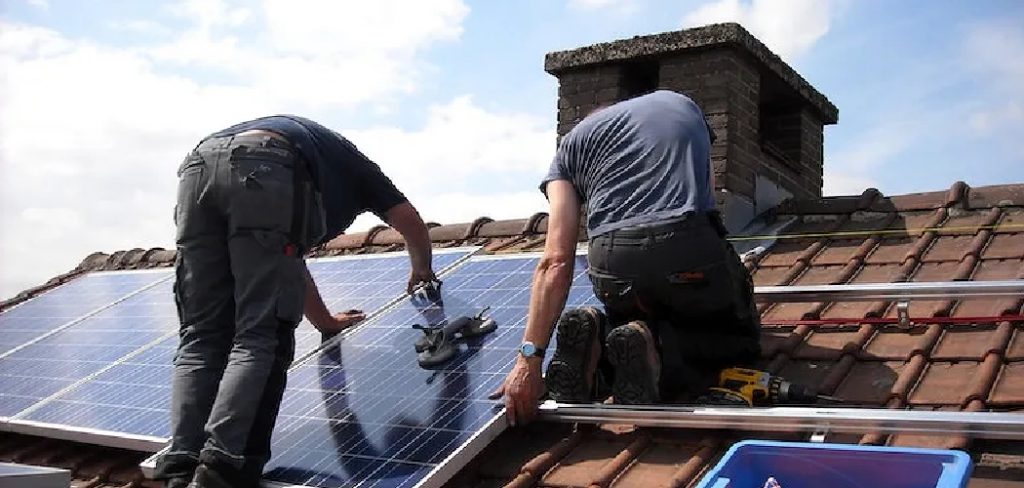
We will explore various techniques designed to protect individuals from falls and injuries, ensuring that roofers can focus on their tasks without compromising on safety. By adhering to these guidelines, individuals can significantly reduce the likelihood of accidents, making roof work safer for everyone involved.
Assessing Roof Conditions
Before ascending any roof, a thorough assessment of the conditions is essential for ensuring your safety. This evaluation process includes examining the roof type and slope, the roofing material’s condition, and current weather conditions.
A. Roof Type and Slope
The type of roof and its slope are crucial factors in determining the specific safety precautions needed. Roofs can vary significantly, from flat to steeply pitched, and each presents its own set of challenges. Flat roofs may provide more stable footing but can be slippery when wet, while steep roofs require specialized equipment such as roof jacks and harnesses to prevent falls. Identifying the degree of slope will help you select the appropriate safety gear and techniques to secure yourself safely on the roof.
B. Roof Material
The condition and stability of the roofing material are just as important to evaluate. Different materials, such as asphalt shingles, tiles, or metal panels, can greatly affect footing and how you move across the roof. For instance, metal roofs can become extremely slick when wet, and aged or damaged shingles can break or give way underfoot. Assessing the material’s condition before work begins helps in planning the safest approach to navigating the roof, ensuring that the risk of slips, trips, and falls is minimized.
C. Weather Conditions
Lastly, checking the weather forecast is imperative before attempting any roof work. Weather conditions can change rapidly, turning a safe environment into a hazardous one in a matter of minutes. Rain, high winds, and extreme temperatures can affect your ability to safely secure yourself on a roof.
It is essential to avoid roof work during inclement weather or when high winds are predicted, as these conditions can vastly increase the risk of accidents. Always plan roof work for clear, calm days, and if the weather turns during a project, be prepared to halt work and secure the site until conditions improve.
How to Secure Yourself on A Roof: Using Proper Safety Equipment
Safety equipment is integral in ensuring the well-being of individuals working on roofs. Understanding and employing the correct gear to protect oneself from potential falls and accidents is crucial. This section highlights the essential safety equipment needed for roof work.
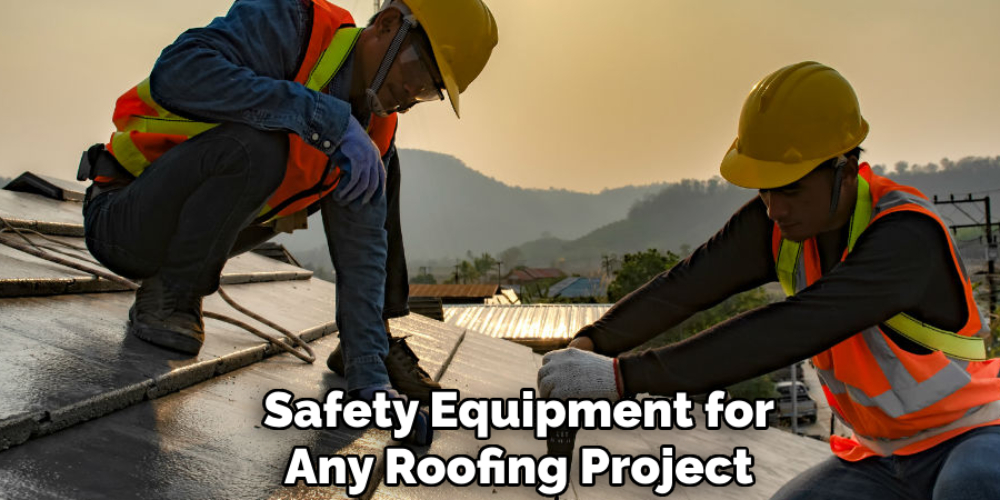
A. Safety Harness
One of the most critical pieces of safety equipment for any roofing project is the full-body safety harness. This harness should be worn at all times while on the roof. It includes a durable lanyard or lifeline that should be securely attached to a stable anchor point. This setup ensures that the individual is caught by the harness rather than falling off the roof in the event of a slip or fall. The harness distributes the force of the stop across the body, minimizing the risk of injury.
B. Roof Anchors
To facilitate the use of safety harnesses, roof anchors or tie-off points must be installed on the roof. These anchors are secure points to which the safety harness lanyard or lifeline can be attached. These anchors must be properly installed and tested to bear the weight and force of a fall. When selecting anchors, consider the roof’s structure and material to ensure compatibility and stability.
C. Personal Protective Equipment
In addition to utilizing a safety harness and roof anchors, wearing appropriate personal protective equipment (PPE) is imperative. Non-slip shoes or boots are essential to provide stability and prevent slips on the roof surface. A hard hat protects from potential head injuries that could occur from falls or objects falling onto the roof.
Gloves protect the hands and improve grip, reducing the chance of slipping or dropping tools. Together, these pieces of PPE form a comprehensive safety ensemble that reduces the risk of slips, trips, and falls, ensuring that workers can perform their duties with an added layer of protection.
Employing the proper safety equipment is non-negotiable when it comes to roof work. By adhering to these guidelines and ensuring that each piece of gear is used correctly and in good condition, roofers can significantly mitigate the risks associated with working at heights.
How to Secure Yourself on A Roof: Practicing Safe Roof Access
Safe access to roofs is a critical component of overall roof work safety, requiring careful planning and the use of appropriate equipment. Ensuring safe ingress and egress reduces the risk of falls and injuries, setting a precedent for safety throughout the entirety of the roofing project. This section outlines the best practices for achieving safe roof access.
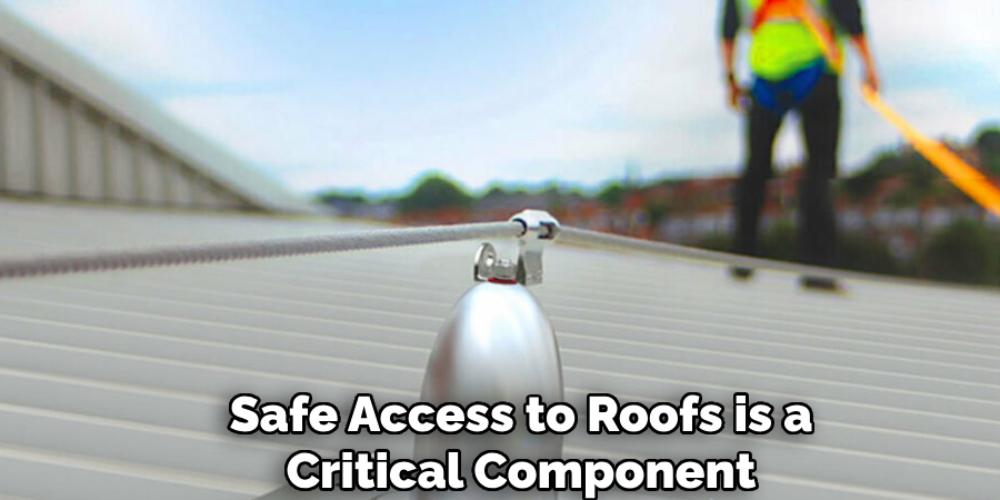
A. Using Stable Ladders
The first step in safe roof access is selecting and using ladders that are sturdy, well-maintained, and equipped with non-slip feet. Ladders should always be inspected before use to check for defects or damage that could compromise stability. When positioning a ladder against the roof edge, it is important to ensure it is placed at the correct angle – the general rule of thumb is for every four feet in height the ladder reaches, the base should be one foot away from the wall.
This angle prevents the ladder from being too steep or too shallow, both of which can lead to accidents. Additionally, the top of the ladder should extend at least three feet beyond the roof edge to provide a secure grip when transitioning from the ladder to the roof and vice versa.
B. Establishing Access Points
Identifying and utilizing safe access points are key factors in mitigating roof entry and exit risks. Workers should use built-in access features such as roof hatches, skylights (if designed for access), or permanent ladders whenever possible. These points are typically designed to offer safer and more stable access than temporary solutions like portable ladders. Ensuring that these access points are in good condition and free of obstructions is vital for maintaining safe access routes on and off the roof.
C. Utilizing Assistive Devices
For additional safety, the use of specialized roof access equipment can greatly enhance the security of moving to and from elevated surfaces. Devices such as roof walkways, guardrails, and rope descenders provide structural support and fall protection and aid in the safe ascent and descent from heights.
Roof walkways, for instance, create a stable, flat surface that reduces the risk of slips and falls on steep or uneven roofing materials. Guardrails offer a physical barrier to prevent falls from edges, while rope descenders can be used when traditional ladder access is not feasible, allowing for controlled and safe descent and ascent.
By implementing these practices for safe roof access, workers are better protected from the inherent risks of height and uneven work surfaces. This proactive approach to safety ensures that the health and well-being of those involved in roof work are prioritized, laying the foundation for a secure and efficient work environment.
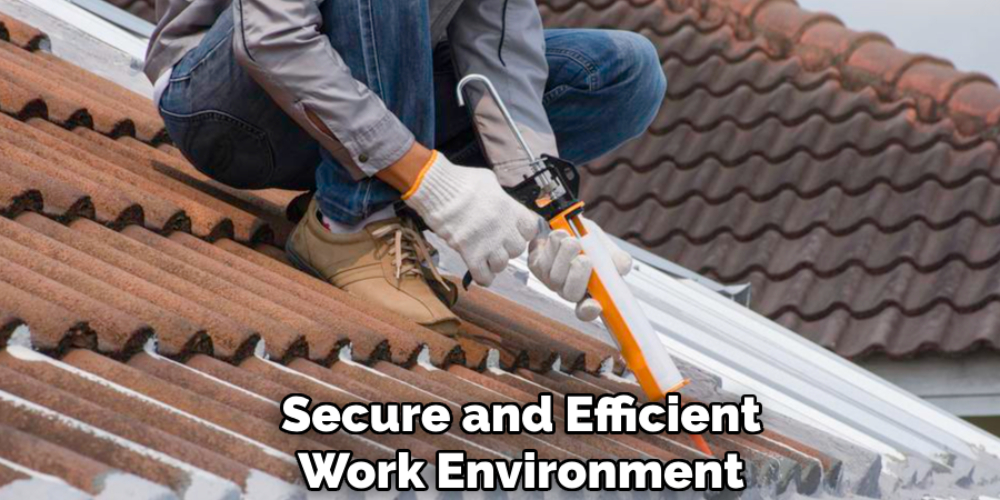
Moving Safely on the Roof
Ensuring safety while moving on the roof is paramount to preventing slips, trips, and falls. This section covers key practices for maintaining safety when navigating roof surfaces.
A. Maintaining Three Points of Contact
One of the fundamental rules for moving safely on a roof is maintaining at least three points of contact with the roof at all times. This means that both feet and at least one hand, or both hands and at least one foot, should be in contact with the roof or a stable structure on the roof.
This approach significantly reduces the risk of losing balance and falling. Workers should move slowly and deliberately When reaching for tools and materials, ensuring that they do not compromise their stability by breaking this three-point contact.
B. Watching Your Step
Awareness of the roof surface conditions is crucial for safe movement. Workers should constantly look for potential hazards such as wet spots, loose shingles, debris, or unexpected obstacles. These hazards can easily cause slips or falls, especially when carrying tools or equipment that may obstruct one’s view of the roof surface.
Regularly cleaning debris and immediately addressing any loose materials or damage can help minimize these risks. Additionally, extra caution and preventive measures should be taken to ensure safety during weather conditions that may affect the roof’s surface—such as rain, snow, or ice.
C. Avoiding Distractions
Distractions can be a significant risk factor for accidents on the roof. It is essential to maintain focus on the task at hand and be constantly aware of one’s surroundings and position on the roof. Avoiding non-essential communication, loud music, or any activity that could divert attention from safely performing the job is critical.
In environments where communication is necessary, workers should ensure they are stationary and in a safe position before engaging, minimally impacting their concentration and balance.
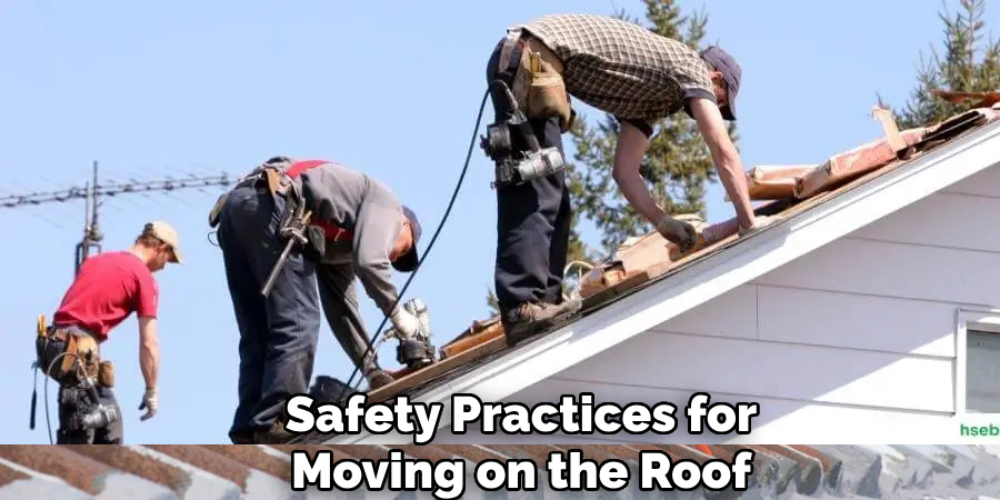
Adhering to these safety practices for moving on the roof not only helps in preventing accidents but also ensures that roofing projects are completed efficiently and without injury. It underscores the importance of a methodical and safety-first approach in all aspects of roof work, from preparation to execution.
Securing Tools and Equipment
Securing tools and equipment while working on a roof is of paramount importance not only for the safety of the workers but also to ensure a streamlined and efficient workflow. Mismanagement of tools can lead to accidents that could have been easily avoided with proper precautions.
A. Using Tool Belts or Holsters
Adopting tool belts or holsters is a fundamental approach to carrying tools and equipment. By allocating each item to a specific place on their person, workers can keep their hands free for climbing and balancing, which is critical for maintaining safety.
Additionally, the risk of dropping tools, which could cause injury to individuals below or damage the tools themselves, is significantly reduced. These tool belts or holsters must be made of durable materials to withstand the rigors of roofing work, ensuring that they don’t fail when most needed.
B. Tethering Equipment
Employing tethers or retractable lanyards can be a lifesaver to further prevent the risk of dropping tools or equipment from the roof. This method involves attaching tools to a secure point on the worker’s belt or to a stationary object on the roof, allowing for ease of use without the risk of a tool falling if accidentally dropped. The retractability feature of some lanyards ensures that tools are not only secured but also easily reachable, providing a balance between safety and work efficiency.
C. Creating Work Zones
Another crucial aspect of securing tools and equipment is the establishment of designated work zones on the roof. Within these areas, tools and materials should be neatly organized and secured to prevent any unnecessary movement that could lead to slips or trips.
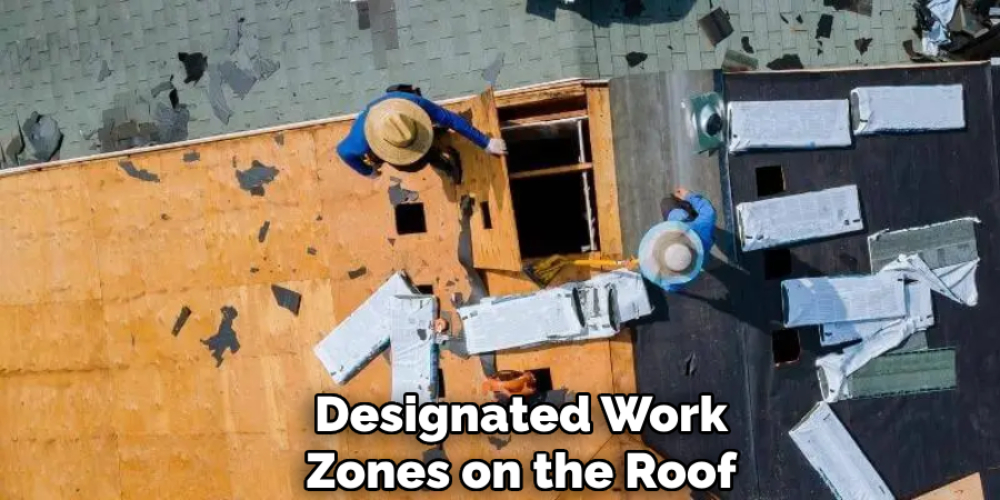
These zones also help keep the work area efficient, as workers have clear access to the tools they need without having to search for them, thereby significantly reducing the risk of accidents related to disorganization. Establishing these zones necessitates a systematic approach to work, highlighting the importance of planning and discipline in maintaining a safe roofing environment.
Communicating and Working with Others
Effective communication and teamwork are crucial to maintaining safety and efficiency on roofing projects. By working closely with partners or teams and adhering to established communication protocols, workers can significantly mitigate risks associated with roofing tasks.
A. Teamwork and Communication
Working in pairs or teams on roofing projects can enhance safety and productivity. It allows for the distribution of tasks in a manner that ensures continuous oversight and assistance if a risky situation arises.
Clear and concise communication is paramount; workers should establish simple, understandable signals or commands to coordinate movements, especially when noise levels are high or visual contact is impossible. Utilizing two-way radios can also facilitate real-time communication across different areas of the roof.
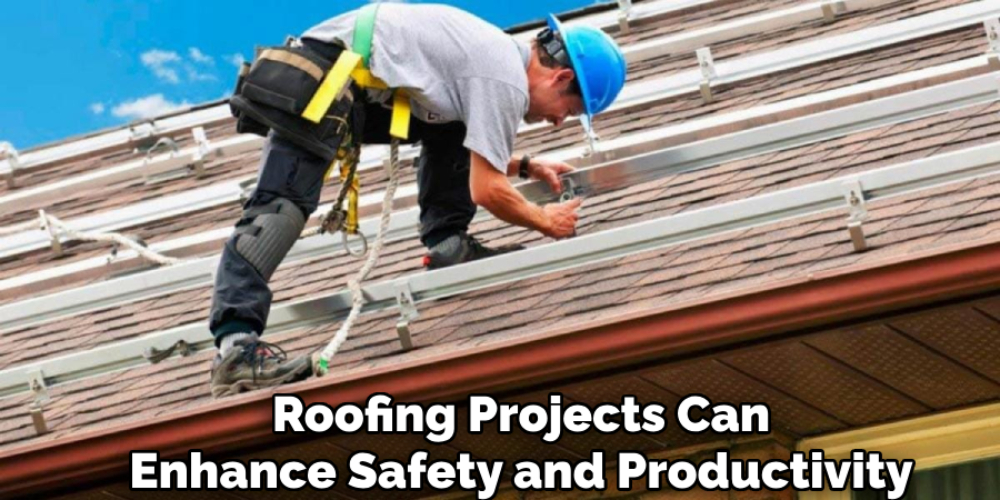
B. Emergency Procedures
Before commencing work, it is essential to establish and review emergency procedures and communication protocols with all team members. This includes identifying the locations of emergency exits and equipment, understanding the process for reporting accidents or injuries, and knowing how to initiate a rescue operation if someone is in danger.
Regular drills and discussions on these protocols can ensure that everyone knows how to react swiftly and efficiently in an emergency.
C. Seeking Assistance
Recognizing the limits of one’s expertise is key to maintaining safety on the roof. Workers should be encouraged to seek assistance or professional help when faced with tasks that exceed their skills or involve complex safety challenges. This encourages a safety-first culture and ensures that tasks are completed correctly and safely, minimizing the risk of accidents or injuries
Establishing a clear procedure for requesting help or additional training can support this approach, ensuring that workers feel confident and secure in their roles.
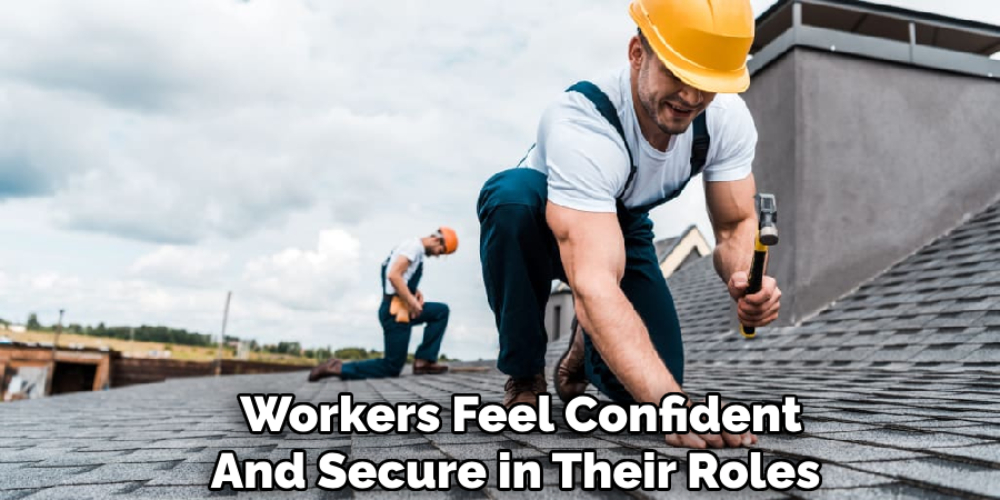
Frequently Asked Questions
Q1: What Are the Most Important Safety Practices when Working on A Roof?
A: The most important safety practices include wearing appropriate personal protective equipment (PPE), ensuring the roof is stable and secure before starting work, avoiding distractions, and securing tools and equipment to prevent falls.
Q2: How Can Roof Workers Prevent Tools from Falling Off the Roof?
A: Workers can prevent tools from falling by using tool belts or holsters to keep tools attached to their person, employing tethers or retractable lanyards to secure tools to a stable point, and establishing designated work zones where tools are organized and secured.
Q3: What Should Be Done if A Worker Is Not Confident in Performing a Specific Task on The Roof?
A: If a worker is unsure about a task, they should seek assistance from a supervisor or a more experienced team member. Establishing a clear procedure for requesting help ensures that tasks are completed safely and correctly.
Q4: Why Is Communication Important in Roofing Projects?
A: Effective communication ensures that all team members are aware of their roles, the tasks ahead, and any potential hazards. It enables workers to coordinate movements, request assistance, and respond quickly in emergencies, significantly reducing the risk of accidents.
Q5: What Actions Should Be Taken in Case of An Emergency on The Roof?
A: In case of an emergency, workers should follow the established emergency procedures, which include identifying emergency exits and equipment, knowing the process for reporting accidents, and initiating a rescue operation if necessary. Regular drills and discussions on these protocols are crucial for efficient and swift response to emergencies.
Conclusion
This guide outlined essential safety techniques and practices for roofing, from the initial preparation and utilizing personal protective equipment to how to secure yourself on a roof. We covered the significance of adopting a proper ladder setup, navigating roofs safely, managing tools and equipment, and the vital role of communication and teamwork.
Prioritizing safety cannot be overstated; it is the foundation upon which productive and successful roofing projects are built. Adherence to the practices discussed ensures not only personal safety but also the well-being of team members and the roof’s structural integrity.
We wish you the utmost success in your roofing endeavors and urge you to continuously prioritize safety. By integrating these safety measures into your routine, you empower yourself and your team to complete projects efficiently and without harm. Remember, a moment spent securing safety is invaluable. Happy roofing!
About
Safety Fic is a distinguished figure in the world of Diy design, with a decade of expertise creating innovative and sustainable Diy solutions. His professional focus lies in merging traditional craftsmanship with modern manufacturing techniques, fostering designs that are both practical and environmentally conscious. As the author of diy, Safety Fic delves into the art and science of Safety Fic-making, inspiring artisans and industry professionals alike.
Education RMIT University
(Melbourne, Australia) Associate Degree in Design (Safety Fic) Focus on sustainable design, industry-driven projects, and practical craftsmanship. Gained hands-on experience with traditional and digital manufacturing tools, such as CAD and CNC software.
Nottingham Trent University
(United Kingdom) Bachelor’s in diyfastly.com and Product Design (Honors) Specialized in product design with a focus on blending creativity with production techniques. Participated in industry projects, working with companies like John Lewis and Vitsoe to gain real-world insights.
Publications and Impact
In diy, Safety Fic his insights on indoor design processes, materials, and strategies for efficient production. His writing bridges the gap between artisan knowledge and modern industry needs, making it a must-read for both budding designers and seasoned professionals.
